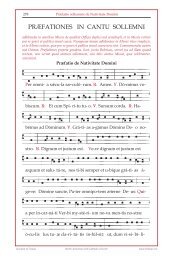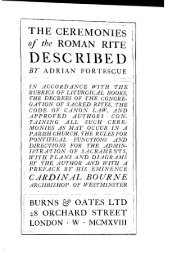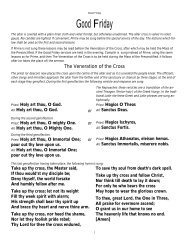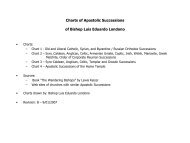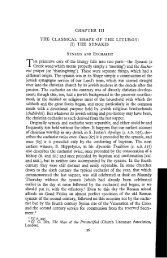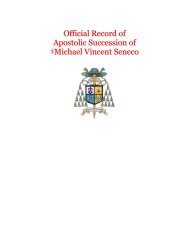Eucharist and Lord's Supper
Eucharist and Lord's Supper
Eucharist and Lord's Supper
Create successful ePaper yourself
Turn your PDF publications into a flip-book with our unique Google optimized e-Paper software.
oo<br />
THE SHAPE OF THE LITURGY<br />
must have continued uninterruptedly throughout the second century if<br />
only as a private observance-at Rome as well as elsewhere·-for so much<br />
jewish custom in connection with it to have been h<strong>and</strong>ed down by tradition<br />
to the days of Hippolytus <strong>and</strong> other later writers. In the form of charitable<br />
'treats' for the poorer christians it lasted into the fifth century in most<br />
churches, <strong>and</strong> in association with old pagan customs of funeral feasts it is<br />
not wholly extinct to this day in the East,! <strong>and</strong> in Abyssinia, while its more<br />
indirect survival in the pain binit of French churches (which are a survival<br />
of unconsecrated offertory breads) is wellknown.<br />
The word agape by the end of the second century had acquired for<br />
Tertullian in the West just as much as for Clement of Alex<strong>and</strong>ria in the<br />
East the purely christian technical sense of a religious supper apart from<br />
the eucharist, just as clearly as the word eucharistia had acquired for them<br />
both the equally technical sense of the rite of the New Covenant, the<br />
bread <strong>and</strong> cup pronounced to be the <strong>Lord's</strong> Body <strong>and</strong> Blood, celebrated<br />
apart from a supper. Ifwe can fix with any precision the period in which<br />
these two words were first accepted among christians generally as conveying<br />
their particular technical meanings, which do not by any means suggest<br />
themselves from ordinary Greek usage, then we shall have established the<br />
date of the separation of eucharist <strong>and</strong> agape. The two technical terms<br />
would not have existed without the need for distinguishing the two things.<br />
'The <strong>Lord's</strong> supper' would have sufficedto describe them in combination,<br />
as it had for S. Paul.<br />
In Ignatius (c. A.D. lIS) the word eucharistia has everywhere without<br />
doubt its technical meaning of a rite. This strengthens the conclusion that<br />
when he tells the Smyrnaeans that neither 'eucharist' nor 'agape' is to be<br />
celebrated apart from the bishop, he means two different rites, <strong>and</strong> that<br />
'agape' no less than 'eucharist' is here a technical term, as it also appears<br />
to be in Jude 12. The abrupt use ofthe word without explanation in both<br />
documents argues a general familiarity with it, <strong>and</strong> since the term implies<br />
the thing, the agape apart from the eucharist must have been familiar, in<br />
Syria <strong>and</strong> Asia Minor at all events, by A.D. 100. If we may take it that the<br />
two rites had not been separated when S. Paul wrote I Cor. xi. (c. A.D. 54)<br />
-he never uses either eucharistia or agape as terms for a rite-we have<br />
thus a period of about fifty years in which we must place both the separation<br />
of the two rites <strong>and</strong> the establishment of that 'four-action shape' of the<br />
eucharistic liturgy which was universal in the second century <strong>and</strong> ever<br />
after.<br />
The direct evidence will not allow us to press the question any closer,<br />
but in estimating the probabilities there are certain points to be weighed.<br />
1 For a late collection of prayers for the agape in this form used among ~he<br />
Nestorians cf. Dom M. Wolff, Ostsyrische Tisch- lind Abendmahlsgebete, Orlens<br />
Christianus, III. ii. I (1927),PP. 70 sq. For the better known traces of the agape in the<br />
Eastern Churches see Tischgebete und Abendmahlsgebete in der Altchristlichen und in<br />
der Griechischen Kirche, E. v. der Goltz, Leip7;g, 1905 (T.U. xxix. ii).



